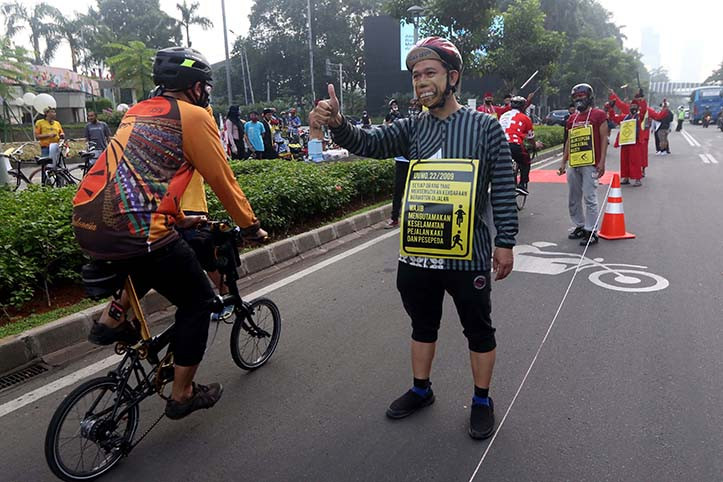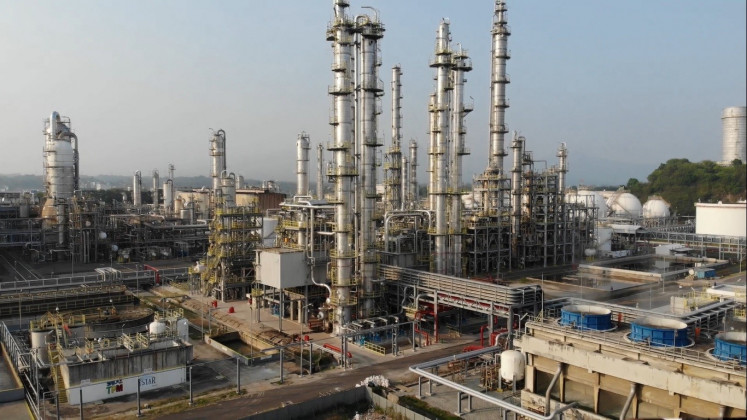One more bicycle, one less car
In Jakarta, where motorized vehicles number 22 million units, 75 percent of the city’s air pollution stems from pollutants expelled into the air by motorized vehicles.
Change text size
Gift Premium Articles
to Anyone

N
o matter what divides us, one of the things that this coronavirus pandemic has made us realize is that we cannot live sustainably if we go on living our lives unchanged.
What exactly is sustainable living? There are many definitions. This, however, will suffice our needs: Sustainable living is a practical world view or a lifestyle that attempts to reduce an individual’s or society’s use of the Earth’s natural resources and one’s personal resources. It also means understanding how our lifestyle choices impact the world around us and finding ways for everyone to live better and lighter.
More simply, it is a method of reducing one’s carbon footprint — the amount of carbon dioxide (CO2) and other carbon compounds emitted due to personal and societal activities.
Sustainable living can make a big-scale change, impact the local environment, lead to a better quality of life in cities and save money. The good thing is, it is within reach. One option is to make cycling part of our daily lives.
With that in mind, we can boldly state that there is a role of cycling in sustainable living.
Here is the thing: The definition of sustainable living mentions the various negative environmental concerns. This may lead to the question: What concerns might affect our goals of sustainable living?
Everywhere in this world, cities are confronted by several problems that might affect our well-being. If we look closer, of all those problems, these are the most alarming issues that are affecting our quality of life: air pollution, traffic congestion, the high fatality rate in traffic accidents and a sedentary lifestyle. One thing is common between these problems, especially in terms of mobility: that people are highly dependent on motorized vehicles.
Let’s take a look at each one of those problems.
In Jakarta, where motorized vehicles number 22 million units, 75 percent of the city’s air pollution stems from pollutants expelled into the air by motorized vehicles, according to the Jakarta Environmental Agency.
By monitoring PM 2.5 — tiny particles in the air that are two-and-a-half microns or less in size that are harmful to people’s health – research by Vital Strategies and the Bandung Institute of Technology has found that 32 to 57 percent are contributed by motorized vehicles. And we have to acknowledge that most of those motorized vehicles are privately owned.
The nearest sector that could be immediately impacted by the poor air quality is public health. Data collected by the Global Alliance on Health and Pollution in 2019 shows that air pollution has caused 123,000 early deaths per year. However, it has been acknowledged as well that toxic gas emissions from motorized vehicles are the major factor behind the climate crisis – which scientists say can potentially make virus outbreaks more common and more dangerous.
Air pollution, of course, can be worsened by congestion. But in a more “practical” way, the problem regarding congestion is how it costs the economy by reducing productivity as a result of time wasted on the road. Based on the findings of a survey conducted by the National Development Planning Agency (Bappenas) in 2018, the negative impact endured by Jakarta and its surrounding cities reaches Rp 100 trillion a year. The fact that road widening or construction does not address traffic congestion doesn’t seem to bother the government as it looks for alternative measures.
That is also the case with traffic accidents. It seems that so far, we are lacking a sense of urgency regarding our high fatality rate from road accidents. According to data from the Transportation Ministry, traffic accidents cause three deaths every hour. This should be considered a tragedy and initiate serious efforts to improve road safety.
Like road accidents, a sedentary lifestyle is the cause of millions of deaths every year worldwide. Referring to guidance from the World Health Organization, for adults, active means doing at least 150 minutes of moderate-intensity aerobic physical activity every week. Anything less than that will affect one's health. People who are insufficiently active have a higher risk of becoming obese and get noncommunicable diseases such as heart disease, stroke, diabetes and several forms of cancer. A sedentary lifestyle will increase the cost of public health.
According to the WHO, 60 to 85 percent of the population worldwide does not engage in enough activity. Globally, a sedentary lifestyle causes 5.3 million deaths every year, four times as much as the number of deaths from traffic accidents.
From the mobility point of view, cycling is a reasonable way to sustainably get out of those problems; cycling especially, could serve short trips. The importance of cycling in tackling the climate crisis has also been concluded by study after study that many consider a game-changer.
But why cycling? First and foremost, cycling is non-polluting. According to the European Cyclists Federation, riding a bicycle accounts for about 21 grams of CO2 emission per kilometer, more than 10 times less than a car. And because it takes less energy to go cover certain distances, cycling is efficient as a means of mobility in the city, especially for short distances and first- and last-mile trips. One hundred calories can power a cyclist for 5 km, but it would only power a car 85 meters.
By taking up cycling, rather than driving a car or riding a motorcycle, a person helps reduce congestion and the travel time of other road users, particularly in urban areas. There’s a saying that goes: one more bicycle, one less car. Getting more people out of cars and onto bicycles would be a good thing for those who really need to use cars or motorcycles.
Second, getting people out of their cars, or off their sofas, is another reason why cycling is a plausible way to make a sustainable living. By cycling, we can be physically active in order to stay healthy while at the same time, make the air cleaner.
***
The writer is a freelance journalist and volunteer of Bike to Work (B2W) Indonesia









